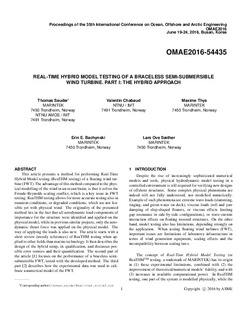| dc.contributor.author | Sauder, Thomas Michel | |
| dc.contributor.author | Chabaud, Valentin Bruno | |
| dc.contributor.author | Thys, Maxime | |
| dc.contributor.author | Bachynski, Erin Elizabeth | |
| dc.contributor.author | Sæther, Lars Ove | |
| dc.date.accessioned | 2017-11-05T12:21:23Z | |
| dc.date.available | 2017-11-05T12:21:23Z | |
| dc.date.created | 2016-11-01T14:32:15Z | |
| dc.date.issued | 2016-06 | |
| dc.identifier.citation | ASME 2016 35th International Conference on Ocean, Offshore and Arctic Engineering - Volume 6: Ocean Space Utilization; Ocean Renewable Energy | nb_NO |
| dc.identifier.isbn | 978-0-7918-4997-2 | |
| dc.identifier.uri | http://hdl.handle.net/11250/2464081 | |
| dc.description.abstract | This article presents a method for performing Real-Time Hybrid Model testing (ReaTHM testing) of a floating wind turbine (FWT). The advantage of this method compared to the physical modelling of the wind in an ocean basin, is that it solves the Froude-Reynolds scaling conflict, which is a key issue in FWT testing. ReaTHM testing allows for more accurate testing also in transient conditions, or degraded conditions, which are not feasible yet with physical wind. The originality of the presented method lies in the fact that all aerodynamic load components of importance for the structure were identified and applied on the physical model, while in previous similar projects, only the aerodynamic thrust force was applied on the physical model. The way of applying the loads is also new. The article starts with a short review (mostly references) of ReaTHM testing when applied to other fields than marine technology. It then describes the design of the hybrid setup, its qualification, and discusses possible error sources and their quantification. The second part of the article [1] focuses on the performance of a braceless semi-submersible FWT, tested with the developed method. The third part [2] describes how the experimental data was used to calibrate a numerical model of the FWT. | nb_NO |
| dc.language.iso | eng | nb_NO |
| dc.relation.ispartof | ASME 2016 35th International Conference on Ocean, Offshore and Arctic Engineering - Volume 6: Ocean Space Utilization; Ocean Renewable Energy | |
| dc.relation.ispartofseries | ASME Digital colletion;OMAE2016-54435 | |
| dc.subject | Semi-submersible offshore structures | nb_NO |
| dc.subject | Testing | nb_NO |
| dc.subject | Wind turbines | nb_NO |
| dc.title | Real-time hybrid model testing of a braceless semi-submersible wind turbine. Part I: The hybrid approach | nb_NO |
| dc.type | Chapter | nb_NO |
| dc.description.version | acceptedVersion | nb_NO |
| dc.rights.holder | Copyright © 2016 by ASME | nb_NO |
| dc.identifier.doi | 10.1115/OMAE2016-54435 | |
| dc.identifier.cristin | 1396277 | |
| dc.relation.project | Norges forskningsråd: 223254 | nb_NO |
| cristin.unitcode | 7566,9,0,0 | |
| cristin.unitcode | 7566,8,0,0 | |
| cristin.unitname | Hydrodynamikk | |
| cristin.unitname | Ocean Engineering | |
| cristin.ispublished | true | |
| cristin.fulltext | postprint | |
| cristin.qualitycode | 1 | |
